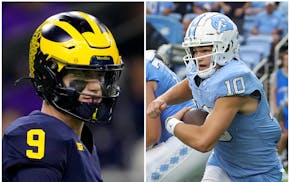Mike Slive concluded his final state-of-the-league address as commissioner of the Southeastern Conference recently by dropping a whopper.
Slive announced that the conference will distribute a record $455.8 million to its members, or $31.2 million per school.
That money stems from TV agreements — including the SEC Network — and the new College Football Playoff and other bowl games.
The Big Ten doled out $30.9 million apiece to its members this year, including $7 million strictly from Big Ten Network revenue, a figure that will get blown out of the water when a new TV contract takes effect in two years.
Early projections indicate that every Big Ten school will receive $44.5 million annually from the conference.
And yet …
"When you hear about the numbers," said Gophers athletic director Norwood Teague, "the perception is that we're rolling in the dough, and we're not."
These are prosperous yet complicated times for college athletics. As a staunch proponent of college sports, I wonder sometimes if the enterprise is flourishing beyond imagination or in the process of self-destructing.
The overwhelming success of conference networks has generated record returns for athletic departments. In their wildest dreams, Big Ten officials couldn't have predicted $45 million payouts a decade ago.
TV pacts have been a godsend to schools, a lifeline for those who pay bills.
The narrative is that everyone in college athletics is getting rich. And they are, especially coaches who shrewdly have used expanding money streams to sweeten their own contracts. Even those who don't necessarily deserve it, such as the current men's basketball coach in Dinkytown.
This all comes at a cost. That's the other side to consider here.
Athletes are keenly aware of the money being pumped into athletic departments and rightfully want and deserve a piece of the pie.
There have been antitrust lawsuits. Northwestern football players voted for unionization. Big schools sought autonomy to draft new rules that would provide more benefits to athletes and temper scrutiny.
The arms race drives decisions in athletic departments. Facility upgrades have become almost mandatory. Coaching salaries are soaring out of control.
College sports never have been more popular, more lucrative and more complicated.
Asked if he worries about TV revenue leveling off at some point, Teague said, "I hope not, because our costs are rising rapidly every year."
That component doesn't get as much attention. In 2006, the Gophers athletic budget was $54 million. Their budget this year is $105 million.
The budget has basically doubled in a decade because administrative costs have skyrocketed — scholarships, travel, salaries, health care, equipment, food, employment numbers, you name it.
The Gophers would be up a creek without that exploding TV revenue. Even with the massive conference payout, Teague said the Gophers struggle to make budget.
"The television side of things is such a lifeline for us," he said. "I'm not singing the blues, but the reality is that we balance our budget on those numbers. It is vital both now and for our future."
Restraint does not seem to be part of the conversation, though, at least in appearance. That's where Teague and others in his position have a perception problem.
Athletic departments take in record revenue distribution yet complain about rising costs that they partly contribute to, particularly with salaries.
The Gophers expanded their donation program for football seating to combat rising costs this year, an unpopular move that has become a national trend. And yet Teague handed Richard Pitino a $400,000 raise after an unsatisfactory season and some agenda-driven rumors that his basketball coach might bolt for Alabama.
Money is tight, but Teague threw significant money at a non-problem. That looks incredibly knee-jerk.
Teague declined to discuss Pitino's situation because nothing official has been announced, but speaking generally, he noted that college administrators operate in a challenging environment.
"It can be a hard sell at times," he said. "But to keep coaches and remain competitive, you've got to be able to invest in those areas."
I've long urged the Gophers to think big in athletics and get serious about football, because to ignore the arms race isn't a realistic solution, either. An overly simplistic answer is to buck the trend and say no. Good luck on that island.
The money being funneled into college athletics has created an undeniable sea change. It makes you wonder how the landscape will look 10 years from now. This much is certain: The toothpaste isn't going back in the tube.
Chip Scoggins • chip.scoggins@startribune.com

Scoggins: Finch feeling heat of the Suns as playoff battle looms
Scoggins: Why 'championship or bust' fits these Wolves

Scoggins: Anatomy of a game-saving play as Correa throws out Ohtani


